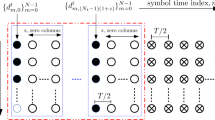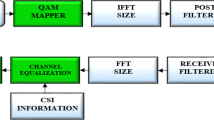Abstract
As a candidate alternative multicarrier scheme for the fifth generation (5G) communication, filter bank based multi-carrier with offset quadrature amplitude modulation (FBMC/OQAM) has better spectral containment, enhanced flexibility and higher spectral efficiency than the popular cyclic prefix orthogonal frequency division multiplexing, thus is more suitable for asynchronous fragmented spectrum access scenarios in future 5G. However, real orthogonality instead of complex orthogonality makes the channel estimation in FBMC/OQAM system challenging, especially when it is combined with MIMO. In this paper, an effective and low complexity compressive sensing based channel estimation method via Generalized approximate message passing (GAMP) algorithm was proposed for the time domain MIMO FBMC system. A Bayesian Cramér–Rao Bound-sparsity (BCRB-s) is obtained considering the sparsity constrain of the channel impulse response. Furthermore, a simplified preamble is brought out and evaluated. Simulation results demonstrate that the proposed scheme is more robust to channel frequency selectivity and always works well even in underdetermined cases. In particular, the performance of our GAMP-based method is close to the BCRB-s. It also showed that a tradeoff between complexity and spectrum efficiency can be made by adjusting the parameters of prototype filters used in FBMC/OQAM system.








Similar content being viewed by others
References
Dahlman, E., Mildh, G., Parkvall, S., Peisa, J., Sachs, J., & Seln, Y. (2014). 5G radio access. Ericsson Review, 6, 2–7.
Dor, J. B., Berg, V., Cassiau, N., & Ktnas, D. (2014). FBMC receiver for multi-user asynchronous transmission on fragmented spectrum. EURASIP Journal on Advances in Signal Processing, 2014(1), 1–20.
Javaudin, J. P., Lacroix, D., & Rouxel, A. (2003). Pilot-aided channel estimation for OFDM/OQAM. In The 57th IEEE Semiannual Vehicular Technology Conference, 2003. VTC 2003-Spring, Jeju, Korea (Vol. 3, pp. 1581–1585).
Lélé, C., Legouable, R., & Siohan, P. (2008). Channel estimation with scattered pilots in OFDM/OQAM. In IEEE 9th Workshop on Signal Processing Advances in Wireless Communications, Recife, Brazil (pp. 286–290).
Lélé, C., Javaudin, J. P., Legouable, R., Skrzypczak, A., & Siohan, P. (2008). Channel estimation methods for preamble based OFDM/OQAM modulations. European Transactions on Telecommunications, 19(7), 741–750.
Kong, D., Qu, D., & Jiang, T. (2014). Time domain channel estimation for OQAM OFDM systems: Algorithms and performance bounds. IEEE Transactions on Signal Processing, 62(2), 322–330.
Kofidis, E., Katselis, D., Rontogiannis, A., & Theodoridis, S. (2013). Preamble based channel estimation in OFDM/OQAM systems: A review. Signal Processing, 93(7), 2038–2054.
Donoho, D. L. (2006). Compressed sensing. IEEE Transactions on Information Theory, 52(4), 1289–1306.
Tropp, J. A., & Gilbert, A. C. (2007). Signal recovery from random measurements via orthogonal matching pursuit. IEEE Transactions on Information Theory, 53(12), 4655–4666.
Chen, S. S., Donoho, D. L., & Saunders, M. A. (2001). Atomic decomposition by basis pursuit. SIAM Review, 43(1), 129–159.
Rangan, S. (2011). Generalized approximate message passing for estimation with random linear mixing. In 2011 IEEE International Symposium on Information Theory Proceedings (ISIT) (pp. 2168–2172). Russia: St. Petersburg.
Chang, R. W. (1966). High-speed multichannel data transmission with bandlimited orthogonal signals. Bell System Technical Journal, 45(10), 1775–1796.
Saltzberg, B. (1967). Performance of an efficient parallel data transmission system. IEEE Transactions on Communication Technology, 15(6), 805–811.
Sahin, A., Guvenc, I., & Arslan, H. (2014). A survey on multicarrier communications: Prototype filters, lattice structures, and implementation aspects. IEEE Communications Surveys & Tutorials, 16(3), 1312–1338.
Bellanger, M., Le Ruyet, D., Roviras, D., Terr, M., Nossek, J., Baltar, L., et al. (2010). FBMC physical layer: A primer. In PHYDYAS.
Tatikonda, S. C., & Jordan, M. I. (2002). Convergence of the sum-product algorithm. In Proceedings 2003 IEEE Information Theory Workshop (Cat. No.03EX674), Paris, France, (pp. 493–500).
Sengijpta, S. K. (1995). Fundamentals of statistical signal processing: Estimation theory. Technometrics, 37(4), 465–466.
Boyer, R., Couillet, R., Fleury, B. H., & Larzabal, P. (2016). Large-system estimation performance in noisy compressed sensing with random support of known cardinality—A Bayesian analysis. IEEE Transactions on Signal Processing, 64(21), 5525–5535.
Zayyani, H., Babaie-Zadeh, M., & Jutten, C. (2010). Bayesian Cramér–Rao bound for noisy non-blind and blind compressed sensing. arXiv:1005.4316.
Tichavsky, P., Muravchik, C. H., & Nehorai, A. (1998). Posterior Cramér–Rao bounds for discrete-time nonlinear filtering. IEEE Transactions on Signal Processing, 46(5), 1386–1396.
Stoica, P., & Moses, R. L. (2005). Spectral analysis of signals (Vol. 452). Upper Saddle River, NJ: Pearson Prentice Hall.
Acknowledgements
The authors would like to thank the reviewers for their elaborative reviews and constructive suggestions, which have helped improve the quality of this paper. This work was supported by National Basic Research Program of China (No. 2013CB329002), China’s 863 Project (No. 2015AA01A706), National Major Project (No. 2016ZX03001023-003), National Natural Science Foundation of China (61631013), Program for New Century Excellent Talents in University (NCET-13-0321) and Tsinghua-Qualcomm Joint Research Program.
Author information
Authors and Affiliations
Corresponding author
Rights and permissions
About this article
Cite this article
Lin, M., Li, Y., Xiao, L. et al. A Compressive Sensing Channel Estimation for MIMO FBMC/OQAM System. Wireless Pers Commun 96, 3345–3360 (2017). https://doi.org/10.1007/s11277-017-4072-z
Published:
Issue Date:
DOI: https://doi.org/10.1007/s11277-017-4072-z




